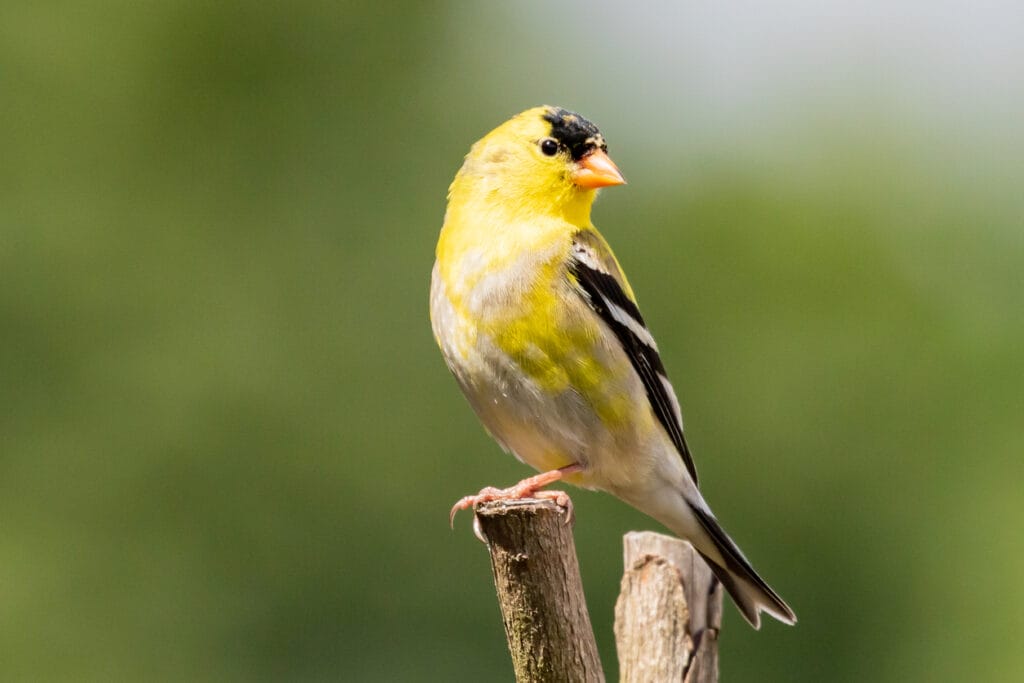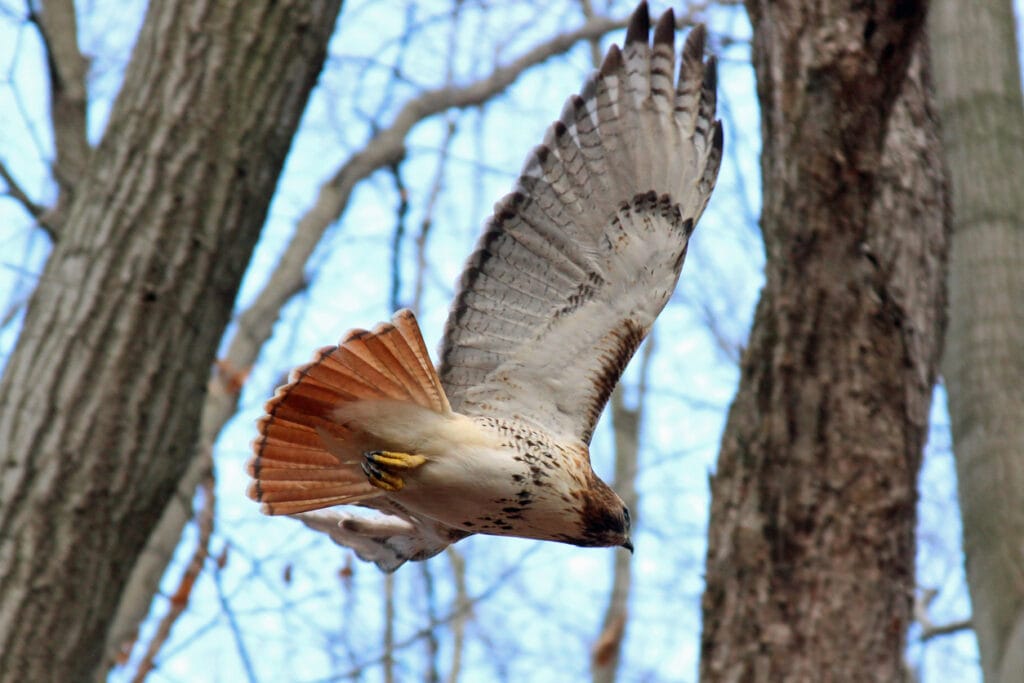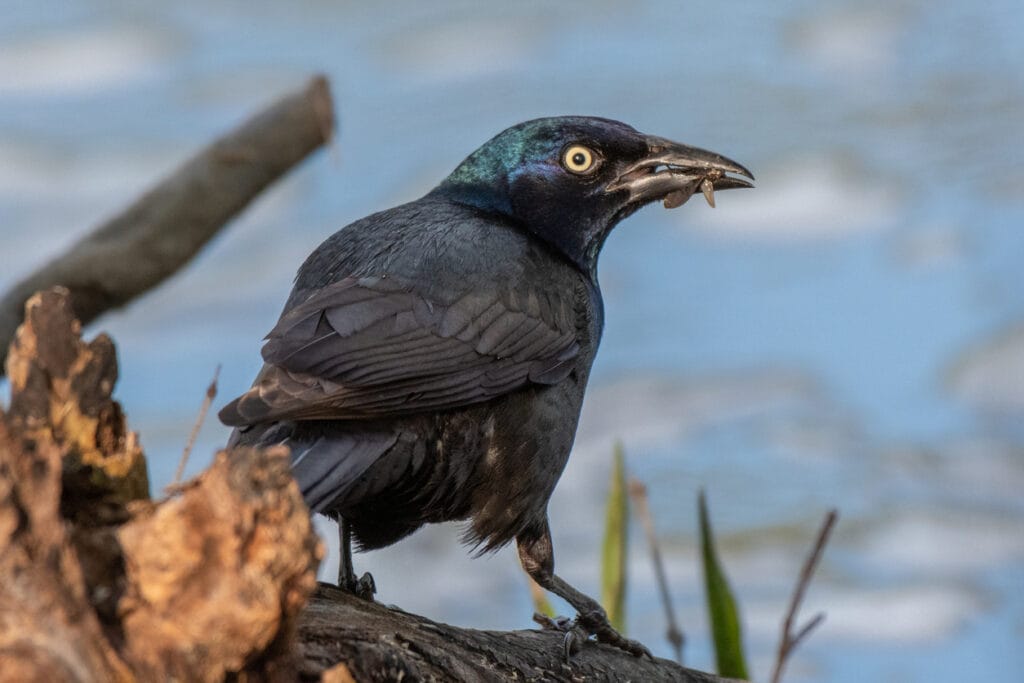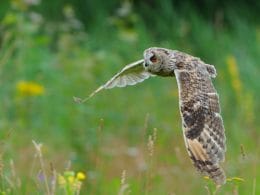In addition to being one of the largest cities in the United States, New York City is also home to a huge range of birds, including backyard birds, birds of prey, and much more!
In fact, according to the New York State Ornithological Association, there are about 495 recorded bird species in New York State, and given the small size of the state, this explains the density and variety of birds!
Note: we have updated our list, as of February 2023 to also include the common Raven and House Sparrow which were previously missing from our list.
19 Most Common Birds in NYC
If you want to find out more about these amazing birds, you’re in for a treat! In today’s guide, we’ll walk you through the most popular birds in NYC. let’s jump right in!
1. Rock Pigeons

- Scientific name: Columba livia
- Length: 11.8 to 14.2 in
- Weight: 9.3 to 13.4 oz
- Wingspan: 19.7 to 26.4 in
Some people also call them “Rock Doves”. These birds are extremely common all over the city and they can be found just about anywhere. They’re so common that many people try to get rid of them.
While the bird’s colors may change depending on its diet and the time of the year, it usually has a bluish-gray coat of feathers with a unique iridescent plumage at the throat area.
Pigeons usually like to gather in large flocks, especially in open areas where they hover around looking for seeds and food remains to feed on. They are one of the most common birds in NYC.
2. Eastern Bluebird

- Scientific Name: Sialia sialis
- Length: 6.3 to 8.3 in
- Weight: 0.9 to 1.2 oz
- Wingspan: 9.8 to 12.6 in
Next on the list is another one of the most popular birds in NYC. In fact, the Eastern Bluebird has been adopted as the official bird of New York State since 1970!
The bird is characterized by its unique plumage of blue that covers the bird’s head, back, and wings, which is found in both males and females of the species, although males are more vibrant than females.
The bird has bronze and white underparts that make it easy to distinguish from western bluebirds, and you can spot them in open woodlands around the city when they’re not perching on communication poles and wires.
Top Tip: They can also make a brief stop by your backyard to catch berries, insects, and mealworms in your birdfeeder.
3. Scarlet Tanager

- Scientific Name: Piranga olivacea
- Length: 6.3 to 6.7 in
- Weight: 0.8 to 1.3 oz
- Wingspan: 9.8 to 11.4 in
Scarlet tanagers are unique birds with a deceiving name, as they’re not actually tanagers and their taxonomical classification has been changed to cardinals a few years ago.
Regardless of the bird’s name, one can’t help but enjoy its vibrant scarlet-orange color that covers most of the bird’s body, except for its black wings. Scarlet tanagers may also land in your backyard to feed on berries and insects.
4. Red-Bellied Woodpecker

- Scientific Name: Melanerpes carolinus
- Length: 9.2 to 10.3 in
- Weight: 2.2 to 3.2 oz
- Wingspan: 15.7 to 17.8 in
New York City has a remarkable range of woodpeckers, but not many species out there are as eye-catching as the red-bellied one!
As the name suggests, this bird has a red coloration on its belly. However, the easiest way to identify it is by heavily checkered black and white back along with the long red patch extending along the male’s nape and head.
Red-bellied woodpeckers may nest in man-made bird boxes but are mostly found in forests around residential areas.
5. American Robin

- Scientific Name: Turdus migratorius
- Length: 9.0 to 11.0 in
- Weight: 2.3 to 2.8 oz
- Wingspan: 14.7 to 16.5 in
American robins are incredibly popular all across America and they’re adopted as official state birds in several states.
The unique thrush songbird is found across the city and may even land around your home if you have a bird feeder.
The bird is known for its reddish-orange underparts and breasts while the rest of its body is usually dark black, including the back and wings.
6. Downy Woodpecker

- Scientific Name: Dryobates pubescens
- Length: 5.5 to 7.1 in
- Weight: 0.7 to 1.1 oz
- Wingspan: 9.8 to 12.1 in
The downy woodpecker is one of the most popular backyard birds, in general, that you can find in New York City. It’s also the most common woodpecker species that you’ll come across.
Author Note: Downy woodpeckers are also the smallest of all woodpeckers in America, so they’re easy to identify even when they look like hairy woodpeckers.
The bird has black and white plumage along with vibrant red feathers covering the back of its neck. They feed on insects, berries, seeds, and will easily land on bird feeders.
7. American Goldfinch

- Scientific Name: Spinus tristis
- Length: 4.3 to 5.5 in
- Weight: 0.39 to 0.71 oz
- Wingspan: 7.5 to 8.7 in
The American goldfinch is one of the most iconic songbirds all across the country and not just in NYC.
These birds have black feathered heads and wings while the rest of their bodies are golden yellow.
These colors are shared by males and females, although males are usually more vibrant, especially during the summer, as they molt during winter and change to a dull brown/olive coat.
8. Northern Cardinal

- Scientific Name: Cardinalis cardinalis
- Length: 8.3 to 9.1 in
- Weight: 1.5 to 1.7 oz
- Wingspan: 8.9 to 12.2 in
Another backyard staple that is fairly common across the city and the state is the Northern Cardinal.
This incredibly vibrant bird has flaming red feathers that cover the vast majority of the male’s body, including the crest on its head. The bird has a black eye mask and a relatively large bill.
The female, on the other hand, is mostly pale brown with orange-red plumage at the crest, tail, and wings.
9. Great Horned Owl

- Scientific Name: Bubo virginianus
- Length: 18.1 to 24.8 in
- Weight: 32.1 to 88.2 oz
- Wingspan: 39.8 to 57.1 in
When it comes to nighttime, no birds are more iconic around New York City than the great horned owl.
In addition to being one of the most common owls in the entire state, the owl is the most well-adapted one to residential areas, so it’s easy to spot one at night.
The bird has long ear tufts with large eyes and black/white/orange alternating lines around its face, which is why some may call it the “tiger owl”.
Author Note: They’re a primary raptor around the city, feeding mainly on squirrels, mice, and other small mammals.
10. Blue Jay

- Scientific Name: Cyanocitta cristata
- Length: 8.6 to 11.8 in
- Weight: 2.5 to 3.5 oz
- Wingspan: 13.3 to 16.9 in
Some people may find the blue jay a nuisance because it’s pretty loud and chatty, but it’s truly a magnificent bird to gaze upon!
The bird has bright sky blue feathers that cover most of its body with a unique checkered cyan coloration on wings and tails. However, this color is due to the feathers’ structure, not pigments, as the feathers are actually white!
The blue jay is pretty smart and can break nuts open, which is rare among birds. It also imitates the calls of raptors, such as hawks, to warn and ward off other birds!
11. Black-Capped Chickadee

- Scientific name: Poecile atricapillus
- Length: 4.7 to 5.9 in
- Weight: 0.3 to 0.5 oz
- Wingspan: 6.3 to 8.3 in
The black-capped chickadee is easily one of the most common backyard birds in New York City. The small bird is quite stocky for its size and has a relatively large head with a thick short bill.
As the name suggests, the bird has a black cap that covers the bird’s cap and bib while the rest of its body is between light gray and white.
To attract these little birds to your backyard, you can use anything from seeds, fruits, or insects, although the bird can even feed on dead parts of animals.
12. Red-Tailed Hawk

- Scientific Name: Buteo jamaicensis
- Length: 17.7 to 22.1 in
- Weight: 24.3 to 45.9 oz
- Wingspan: 44.9 to 52.4 in
The most popular, and perhaps the largest of all raptors in New York City, is the red-tail hawk. This bird of prey likes to fly at very high altitudes, so they’re typically soaring above suburban areas.
Despite its name, the red-tailed hawk can also be found in a wide range of color shades, including brown, black, soft gray, and white. However, the bird will usually rock a relatively long tail that is red in color.
They feed on a wide range of animals, including small mammals like mice and squirrels as well as snakes, frogs, lizards, and more.
13. Red-winged Blackbird

- Scientific name: Agelaius phoeniceus
- Length: 6.7 to 9.1 in
- Weight: 1.1 to 2.7 oz
- Wingspan: 12.2 to 15.8 in
The red-winged blackbird is one of the most iconic species of birds that will visit your bird feeder. The bird is very easy to identify thanks to its unique look.
Males of this species have black plumage covering almost all of their bodies like a regular blackbird, except a small patch of bright red and yellow at the top of their shoulder part of the wings.
While they can be found anywhere around the state, they typically like staying near bodies of freshwater. Keep in mind that these birds are pretty territorial, so you should only appreciate them from a distance.
14. Mourning Dove

- Scientific Name: Zenaida macroura
- Length: 11.8 to 12.2 in
- Weight: 4.3 to 6.4 oz
- Wingspan: 17.3 to 18.2 in
Mourning doves are found all over the state, and their population is in a continuous increase in the Empire State.
These tubby birds are related to rock pigeons, but they’re generally smaller and have a buff or tan plumage with black spots on their wings.
While they prefer living in areas with dense shrubs, they can also be attracted to backyards by spreading seeds and millet around, as they like to feed on the ground.
15. Common Grackle

- Scientific name: Quiscalus quiscula
- Length: 11.0 to 13.4 in
- Weight: 2.6 to 5.0 oz
- Wingspan: 14.2 to 18.1 in
Common grackles are lanky birds that have an iridescent purplish-blue feather coat and a turquoise color head that you shouldn’t miss! They’re another very common bird in NYC.
The females of this species usually rock similar patterns but with a duller overall tone. These birds usually gather in large chatty flocks, so they’re easy to identify.
These birds have a very ample appetite and would gladly enjoy just about any kind of food that they can find, whether it’s seeds, fruits, insects, or even reptiles and small birds!
16. White-Breasted Nuthatch

- Scientific name: Sitta carolinensis
- Length: 5.1 to 5.5 in
- Weight: 0.6 to 1.1 oz
- Wingspan: 7.9 to 10.6 in
The white-breasted nuthatch is one of the most popular backyard birds that you can come across in New York City.
Top Tip: These birds are relatively small and will nest in any man-made bird box, as they’re incredibly adapted to residential areas.
You can also find some of these birds in forests and parks around the city, where you can identify the bird by its white underparts and breasts along with a soft gray head, rump, and back.
17. Northern Harrier

- Scientific Name: Circus hudsonius
- Length: 18.1 to 19.7 in
- Weight: 0.67 to 1.7 lbs
- Wingspan: 40.2 to 46.6 in
The northern harrier is a common species of raptors that live in the city of New York.
The bird is actually classified as a hawk, so they depend on their excellent sense of vision and hearing to spot and catch their prey.
These birds have owl-like faces with slender bodies and long wings that are covered by a brownish plumage.
18. House Sparrow

- Scientific Name: Passer domesticus
- Length: 5.9 – 6.7 in
- Weight: 0.9 – 1.1 oz
- Wingspan: 7.5 – 9.8 in
The House Finch is a small, brightly colored songbird that is common in gardens, parks and residential areas throughout New York City. They have a red head, breast, and rump in males, and brown or streaked in females. They are known for their vibrant, melodic songs and are often attracted to bird feeders with sunflower seeds.
19. Common Raven

- Scientific Name: Corvus corax
- Length: 22.1 – 27.2 in
- Weight: 24.3 – 57.3 oz
- Wingspan: 45.7 – 46.5 in
The Common Raven is a large, intelligent bird species that has in recent years made a comeback in New York City. Known for its distinct, deep croak, the raven is a highly adaptable bird that can be found in a variety of habitats, including urban areas. They are known to be very intelligent and playful birds that have been observed using tools, playing games and solving problems. They have also been seen to form complex social bonds and have been observed to mourn the loss of a mate.
Final Thoughts
This wraps it up for today’s guide that walks you through all the unique species of birds in NYC.
We hope that you enjoyed this guide and that you’ve found out more about the incredible variety of birds in this bustling city!
FAQ
The little birds in NYC are commonly referred to as “chirpers” or “city birds.” They can include species such as house sparrows, European starlings, and house finches. Most commonly, the little brown birds are commonly called sparrows. They are small, brown and often seen in flocks.
Some common birds in New York City include American Robin, American Goldfinch, Northern Cardinal, Rock Pigeon, and Dark-eyed Junco.
The most common bird in New York is the Rock Pigeon.
In Queens, New York, some of the bird species that can be found include American Goldfinch, American Robin, Blue Jay, European Starling, and the Northern Cardinal. However, the specific birds found in an area may vary depending on the time of year and habitat.











Why no mention of the sparrow which i see every day?
Yeah I am curious why house sparrows aren’t listed. I see those far more than even pigeons. Also gulls are missing.
Thank you for your comments, we have just updated our list with the House Sparrow as well as several additional birds which were previously not on the list.
I am seeing more and more ravens!
Indeed, apparently they have been making a comeback since 2014-2015 and are now quite common although many people still struggle to distinguish a Crow from a Raven. We’ve added the Raven to our list 🙂